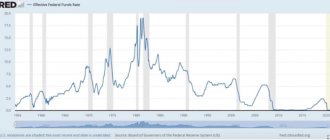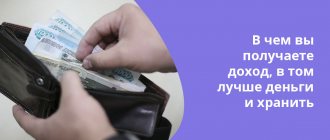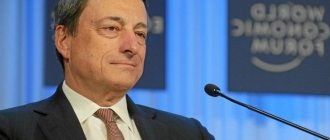Federal Reserve - Interest Rate Chart
The Federal Reserve System in 2018 is an important link in the American and global economic system. Understanding how the Fed works, what processes it influences and what it regulates in the world gives advantages to any novice investor.
The Federal Reserve is the regulator of the US banking system. But, unlike the rest of the world's central banks, in America the central bank is a private structure that was formed at the dawn of the country's independence in 1813, when several national banks of the colonial countries operated on its territory. They did not have enough information to take into account local specifics, and therefore national banks worked ineffectively, especially during periods of crisis.
Federal Reserve Headquarters in Washington
Pandemic pressure
In its message, the American regulator noted that the economy in the future will significantly depend on the spread of coronavirus.
“The ongoing public health crisis will continue to weigh on economic activity, employment, and inflation, and poses significant risks to economic potential over the medium term,” the Fed explained. They added that when taking further steps, the committee will analyze incoming information and is ready to adjust the course of monetary policy if risks arise that could interfere with the achievement of its goals. “In its assessments, the committee will take into account a wide range of information, including data on public health, labor market conditions, inflation pressures and inflation expectations, as well as financial and international events,” the Fed explained.
All ten committee members voted for the measures taken on monetary policy. The next Fed meeting will take place on December 16, 2021 and will be accompanied by an updated macroeconomic forecast.
Fed rate
The principle of issuing dollars into the US economy is as follows: in fact, the state borrows dollars from the Fed by selling it its government debt bonds, which are repaid later with interest. The amount of this interest is the Federal Reserve's federal funds rate.
Since, according to state requirements, banks must always have a certain reserve of funds, the need for loans arises constantly. By adjusting the rate, you can increase or decrease the balance of funds in commercial bank accounts. Loans are provided only for excess funds, i.e. by an amount greater than the required reserve established by the regulator.
The Fed cannot accurately set or determine the refinancing rate in the interbank market. Only the size of the discount rate is determined precisely. The refinancing rate is achieved through open market trading. Therefore, its level is set in a certain range in increments of 0.25% and is called the target rate.
The refinancing rate is key because... affects the size of the loan for ordinary consumers - individuals and legal entities. Banks are not required to use target rates, but use them as a guide. In order to keep the rate within the specified limits, the regulator itself actively trades on the market. The average of bank rates is called the effective federal funds rate.
Fed meetings are held according to the annual schedule. Decisions are made there on the country's monetary policy. These decisions are important for the entire global economy, because The dollar remains the world's main reserve currency.
The meetings end with a press conference by the chairman of the board, where he announces the results of the meeting and answers questions from the press. Results are always posted at 2 pm New York time.
Global indices fell: the importance of the Fed increased with a weak Biden
Russian and European indices are in the red zone today in anticipation of today's statement by the US Federal Reserve on rates and asset repurchase policy on the market.
Russian stock indices - Moscow Exchange and RTS - are declining by 2-3%, and European and Asian ones - by 1-1.5%. Russian assets are also under pressure from the upcoming meeting of the Central Bank of the Russian Federation on Friday, at which a decision may be made to raise rates for the first time after a long period of reduction.
Investors, in anticipation of the Fed's statement, began to play against the ruble. As Sberbank analysts predicted the day before, the ruble will become cheaper, and the dollar may rise in price to 74 rubles after the speech of the head of the US Central Bank, but now the ruble has fallen in price against the dollar to 73.8 rubles, and for the euro they give 87.77 rubles, according to trading data 15:30 Moscow time. All emerging market currencies fell against the dollar in anticipation of the outcome of the Fed meeting: investors are leaving risky assets, preferring lower returns but safety.
Another factor in the decline in the value of Russian assets could be a statement by US President Joe Biden: he promised that Russia would pay for possible interference in the US presidential election. But the US administration announced this investigation and its predictable results back in the first days of the 78-year-old president’s reign at the end of the year, and Biden managed to talk with the Russian leader in January and now once again wants to show how strong and decisive he is. After the announcement of sanctions today, the exchange rate of the ruble and shares did not change: the restrictions will affect the supply of spare parts for specific equipment, for example, chemical laboratory equipment.
The American factor still hangs over the markets like a sword of Domocles - investors face big losses if the health of Biden, who is reminiscent of Leonid Brezhnev, one of a series of elderly Soviet leaders with poor health during a period of state instability and frequent changes of power, faces big losses. The United States is the world's largest economy and largest financial center, and therefore the nation still needs a strong leader who can implement a plan to save the country.
In this situation, the role of the Fed for investors has significantly increased, and the markets, just in case, prepared for the worst - the imminent completion of the redemption of government bonds and the period of low rates. The previous US president tried not to give the Fed much freedom and tried to influence, publicly criticizing the regulator’s leadership for its reluctance to introduce zero and even negative rates.
“An increasing number of FOMC (US Federal Reserve Market Operations Committee) members may predict rate hikes in the coming years. According to the December scatter plot, only one of the 17 FOMC members expected a rate hike from the current level in 2022, and five in 2023,” SberCIB Investment Research said in a commentary.
Fed rate hike
2007 was a difficult year for the American economy. In order to ease the burden of the global crisis, the Federal Reserve came to the aid of the financial system by lowering interest rates in the United States to zero. However, keeping rates at a minimum level for a long time is fraught with an acceleration in the level of inflation, therefore, from 2021, the Fed entered a cycle of increasing the federal funds rate (“tightening” or “normalizing” monetary policy).
The central bank has been open about its intentions to raise rates, but remains tight-lipped about the timing. Expectations of a rate increase lead to a strengthening of the US dollar, and if they are not justified at the next meeting, disappointed investors sell the US currency on the market.
Results and reaction of the euro/dollar exchange rate
What do we end up with? Forecasts for GDP and unemployment rates have been slightly improved. For inflation, the forecasts are almost the same. Over the next 3-4 years there will be 10 interest rate hikes, not 9 as expected in September. That is, Trump's new policy will not affect the rate of interest rate increases?
The Federal Reserve did not voice concerns about a possible faster rise in prices (inflation has been growing at a very high rate in recent months).
There were no clearer comments on interaction with the new government in the United States. But Trump is expected to insist on raising interest rates. These expectations were not reflected in the Fed's rate forecasts.
It is possible that the Federal Reserve does not want to shock the markets and with the coming to power of the new US President, amendments to the forecasts will still have to be made.
It is possible that the current composition of the Fed is in its final months, since Trump may want to change the leadership of the regulator, which he has repeatedly spoken negatively about.
Yellen concluded by saying that the Fed is keeping up with developments. But it is quite likely that in reality it is lagging behind. If the markets understand this, the dollar may continue to rise.
Euro to dollar exchange rate online today
In any case, the EUR/USD pair fell to around 1.055 or by about 0.5-0.8%. All this is dictated by the Fed’s slightly more hawkish rhetoric, but only insignificantly compared to market expectations, experts from ForTrader.org magazine note.
Online discussion of Forex trading
- Current situation, discussion and Forex forecasts (EURUSD, USDJPY, GBPUSD, USDCHF, AUDUSD, NZDUSD)
Rates on deposits and loans in dollars ▲
The Fed's rate hike means that American banks will have to borrow more from the regulator. This means that banks will increase interest rates on loans and deposits. This applies not only to the USA, but in general to dollar loans and deposits anywhere and to anyone.
For example, the basic level of profitability of dollar deposits in Russia since the beginning of the year has increased from 1.88% to 2.7% per annum (for deposits for a period of six months to a year). The Fed rate range over this period increased from 1.25–1.5% to 1.75–2% per annum. The Fed's effective rate (weighted average of all dollar loans) now reaches 1.91%. The Bank of Russia does not like the attractiveness of foreign currency deposits, and it is trying to combat this by increasing the mandatory reserve requirements for foreign currency deposits. We'll see what comes of this.
Fed effective rate (white) and average 1-year dollar deposit rate worldwide (Source: Bloomberg)
Rates for dollar loans around the world are also rising. It will be more difficult for Americans to take out a mortgage, and for foreign countries to service their dollar debt. In the era of zero Fed rates, they (primarily developing countries) scooped up cheap dollar loans. Now they will have to pay more.
As Natalia Orlova, chief economist at Alfa Bank, explains, the profitability of dollar assets is growing, and capital is returning from developing countries to the United States. Other countries find themselves in a kind of “scissors” - dollar investments are flowing away, the national currency is weakening, and servicing external debt is becoming increasingly difficult. Therefore, the risk of a debt crisis is growing in emerging markets.
Opportunity: transfer money from euros to dollars at a higher rate.
Or more simply: where to invest now?
Fed rate changes affect the flow of money around the world. No wonder: The US Federal Reserve controls the cost of money in the largest economy with the leading reserve currency. Now the rate is in the range of 1.75–2% per annum. There have been two increases since the beginning of the year, and two more are expected before the end of the year. We have compiled a cheat sheet for you: how the Fed's actions affect the value of various assets. Simply put, what to pay attention to in order to make money on the actions of the new Fed Chairman Jerome Powell.
Key bets this week
- 11 December 2021, 08:41
- |
- Andrey Khokhrin
This week decisions on key sweat rates will be announced by the US Federal Reserve and the Bank of Russia. The Fed will announce the rate today, after 21-00 Moscow time, the Bank of Russia - on Friday afternoon. There are not enough reasons for reducing (or, even more so, increasing) the Fed rate. The range of 1.5-1.75% should remain unchanged. Reducing the rate, as well as expanding the asset repurchase program, is advisable in the event of a falling market or to stimulate a fading economy. In the States, stocks are at historical highs, and GDP growth is expected at 2.4%. Just a year ago, such conditions were capable of triggering a rise in rates and a reduction in the Fed’s balance sheet. But the latest Fed rate increase occurred simultaneously with the largest drop in stock indices in five years. And since then, having felt the full negative power of tight monetary policy, the American regulator, actively pushed by the country’s president, is faced with the choice of maintaining moderately soft or ultra-soft monetarism. This time the choice should be on the first option.
( Read more )
- thank you ₽
- Fine
- +7










